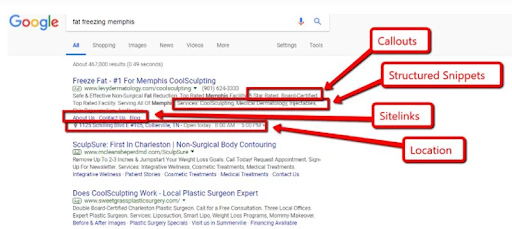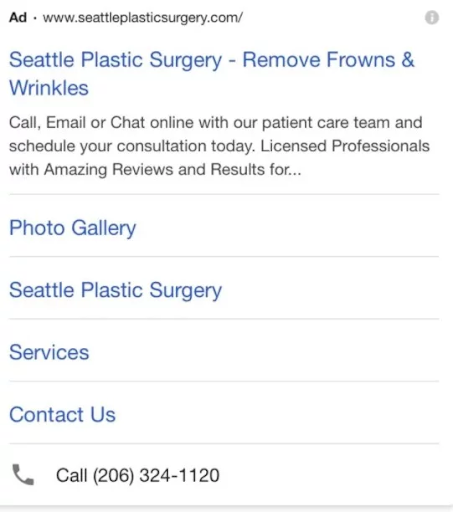Are you planning to launch a unique pay-per-click advertising campaign for your medical practice but not sure where to start?
Companies in every industry can benefit from pay-per-click (PPC) advertising and this is particularly true for hospitals. As healthcare businesses need to target potential customers at every stage to survive in the industry, PPC advertising for healthcare is one of the quickest and easiest ways to attract and connect with new patients when they’re actively searching for a healthcare provider. PPC or pay-per-click is a unique internet advertising tool to direct traffic to websites in which an advertiser pays a publisher when the ad is clicked. With constant focus, monitoring and optimization, PPC campaign management ensure that a website is on top of the search results page instead of getting lost among millions of results. When it comes to healthcare (perhaps more than any other industry), people search online to find answers for their health concerns. Relying on healthcare SEO services from a professional company can help implement an effective strategy to target and attract new clients.
Why Is PPC Advertising Important?
In simple terms, Pay-per-click (PPC) advertising is a marketing tactic where a brand places an online ad for free and pays each time a prospect clicks on it. It can be split into two categories – search advertising and display advertising. In fact, this is a perfect solution for a healthcare marketer planning to strengthen online visibility, drive more traffic to their website, generate quality leads, and increase revenue.
Other benefits that PPC offers healthcare practices include –
- Makes the practice’s website more visible to potential patients
- Helps target very specific group of audiences
- Helps identify topics for content marketing
- Helps show ads to people who have visited particular pages on a website
According to statistics from Promodo, paid search ads in the healthcare industry have the highest conversion rate at 2.6%, outperforming display ads and social media ads. Healthcare organizations typically spend around $51,000 per month on paid search advertising, with 67% of healthcare marketers relying on Facebook Ads. The average click-through rate (CTR) for medical practice PPC campaigns is 3.27%, meaning that 3.27 out of every 100 people click on an ad. To ensure optimal performance, it’s essential to run your PPC ad campaign for at least 90 days, allowing Google’s algorithms to fully take effect.
Which Channels Pay the Most for Healthcare Providers and Medical Centers?
Advertisers can reach thousands of potential patients through a range of channels using PPC marketing for healthcare, including:
- Google: It is the most widely used search engine, and millions of people use it daily to look up potential doctors, urgent care facilities, and other healthcare providers in their area. Your potential new customers will see you prominently if you have Google ads.
- Bing: Internet users over 55 have been found to be the most frequent Bing searchers, so it’s a terrific way to create targeted marketing to reach that particular demographic.
- Facebook: People are using social media platforms like Facebook to communicate with their reliable peers, much like they do with search engines. One excellent strategy to draw attention to your company is to display advertisements when they check in on loved ones.
- YouTube: Videos may be an excellent method to promote your business online. You can post testimonials from current patients, tales about how your care benefited a family in need, and even behind-the-scenes glimpses at your facility.
Here discussed are some important tips or strategies for healthcare PPC campaigns that help increase the return on investment (ROI) on these campaigns –
- Set Advertising Goals – Compared to SEO statistics, PPC statistics are easy to measure, making it easier for healthcare marketers to track return on investment and manage budget. PPC marketing can be used to increase website traffic, patient volume and brand awareness, and generate leads. When planning a PPC campaign, it is important to define the goals that the healthcare provider would like to accomplish as it will help assess the effectiveness of campaigns.
- Know the Type of Audience – One of the important aspects of healthcare PPC marketing is that the ads must be tailored or targeted to specific groups and subgroups for maximum ROI. Make sure to use Google Analytics (GA) to understand what kind of users (whether local/global, younger/older, male /female) get attracted to a specific website. For instance, if you have multiple audience groups, consider launching different PPC ad campaigns for each. Before placing a PPC ad, ask yourself these questions –
- Who is your target audience?
- What type of services are they looking for?
- How do they search for healthcare practices or providers?
- Finding definite answers to these questions will help analyze the target audience’s traits and characteristics, complete with basic demographic information, as well as their considerations, top priorities, and any obstacles that prevent them from choosing a particular healthcare practice or services.
- Revisit Ad Content – Try to make sure that the ads are relevant to the people searching. Even though this may sound a little intuitive, the biggest killer of CTR is serving an ad that a target audience is not looking for in their search results. For instance, if the target audience groups are searching for physicians and the search content is showing a copy for digital imaging, the majority of people won’t click the ad. Having keyword-loaded copy is important. Just be aware about what kinds of ads are showing for a keyword. Make sure they offer something valuable to the people searching.
- Pick the Right Keywords –The basic goal of PPC should be to get fresh prospects to discover a healthcare practice online. Identifying the right keywords that are most likely to result in clicks and conversions is an important aspect in this regard. Typically, a well-organized PPC campaign will include a number of different types of keywords with different levels of intent, such as – brand, low-intent, long-tail and competitive keywords. The smart way to find relevant keywords is to use an online tool like Google Keyword Planner. It helps find keywords that have high search volume, relevant to the service that a healthcare practice is trying to promote and that best fits into their budget.
- Create a Compelling/Responsive Ad Copy – Search engines always tend to show high-quality ads, whose copy is closely related to the search keyword. Creating a compelling and impactful ad copy will increase CTR, which will in turn increase quality score. Quality score is one of the essential metrics a healthcare practice should be focusing on to run more successful campaigns. Responsive display ads (RDAs) – automatically adjust their size and format to fit whatever ad space is available on a page. These can be used through Google Ads, and helps the healthcare center discover the best headline, description, and even image combination. Most importantly, RDAs are instantly suitable for all types of devices – mobiles, tablets, PCs, etc. No matter how the ads are viewed, they will appear in a presentable and visually pleasing form.
- Enable Ad Extensions – Maximize the amount of additional information being shared with audiences by adding extensions. It increases an ad’s click-through-rate by several percentage points, increases visibility, CTR and ROI. Some common ad extensions include –
- Callouts – short 25 character descriptions to highlight what is being offered.
- Sitelinks – include links that populate under your ad to help direct people to the landing pages you select.
- Structured snippets – this extension highlights the services or the type of products offered.
- Location – displays your medical business address, contact number and directions to reach you.
- App – links that direct users to the app store or provide a link to download link of the app.
- Review – includes online reviews which customers tend to trust
It is important to test various extensions and analyze which one works best for your healthcare practice. Keep an eye on the users to know what terms they use for several possible results.
- Focus on Geo-targeting – Also known as location-targeting, this is a paid advertising strategy that is designed to target an audience within a specific geographical area. These strategies can help deliver specific healthcare services to prospective customers based on their geographical location. For instance, if the majority of audiences or customers reside in a specific geographical area, it is important to focus the campaign solely on that specific area rather than wasting the ad budget targeting the entire city. With the right geo targeting strategy in place, healthcare practices can reach the right group of people searching for a service which can improve PPC performance and return on investment.
- Optimize Landing Pages – Landing pages play a critical role in healthcare digital advertising. For instance, when someone clicks on your ad, they arrive on a landing page and this page must deliver on your ad. If it doesn’t, people will return to the search results, which doesn’t help your healthcare advertising initiative. Analyze your landing pages for different ad campaigns. For instance, if your healthcare practice designs an ad promoting emergency medical care – the landing page need to offer additional information about emergency care, like parking, capabilities, and more.
- Optimize Ads for Mobile – As per Statista.com, there are more than 3 billion Smartphone users worldwide. Setting up PPC Ads for mobile is easier because of the level of intimacy that a Smartphone offers. Optimizing these ads would persuade users to click on the ads – whether on the search networks or display networks.
- Take Advantage of Conversion Tracking – Conversion tracking offers a unique platform to gain insight into the type of keywords that drive traffic to the paid ad campaign and prompt people to convert. This report will also provide insight about the negative keywords and help to narrow down the target audience group. Using this feature allows Google to optimize the account with the setting “maximize for conversions,” which will show ads to users who are more likely to convert based on those who have previously done so.
- Conduct PPC Audits – Getting the most value out of healthcare PPC requires regular PPC audits. A PPC audit involves a complete analysis of the advertising strategy, ad campaigns, and ads. These audits help to evaluate where the PPC ads are succeeding and where they aren’t, how long these ads stay relevant, and whether users are finding the solutions they need on the site via these ads. This analysis can provide information regarding what is engaging and what changes need to be incorporated to better target the ads.
- Research Competitor Campaigns – Competing health centers can also provide insight into the healthcare advertising strategy. For instance, using tools like SEMrush would enable you to see competitor ads. Checking Facebook’s ad library can help view an organization’s Facebook and Instagram ads.
- A/B Testing – It is not possible to know and analyze what works best for a healthcare practice without testing. A/B testing for PPC campaigns makes ads more relevant. To test PPC campaign, test the headlines, description, link, keywords, and ad extensions. In addition, testing landing page elements like design, images, CTA, benefits and features is also crucial. Regular A/B testing keeps an eye on CTRs and overall volume but, most importantly focuses on conversions and cost per conversion. However, make sure to test only one element at a time to get proper results as multi elements testing can be convoluted and indeterminate.
Launching and maintaining a healthy PPC campaign for your healthcare practice requires more than a one-time setup. PPC is an on-demand way to strengthen online visibility, increase traffic, and drive profitability. It is also one of the great lead generation strategies for healthcare marketers. However, to get the best results, it is important to follow a strategic approach to set up your health advertising campaigns. An organic SEO company can design the right PPC campaign for healthcare practices to increase website visibility, traffic, and conversions.






